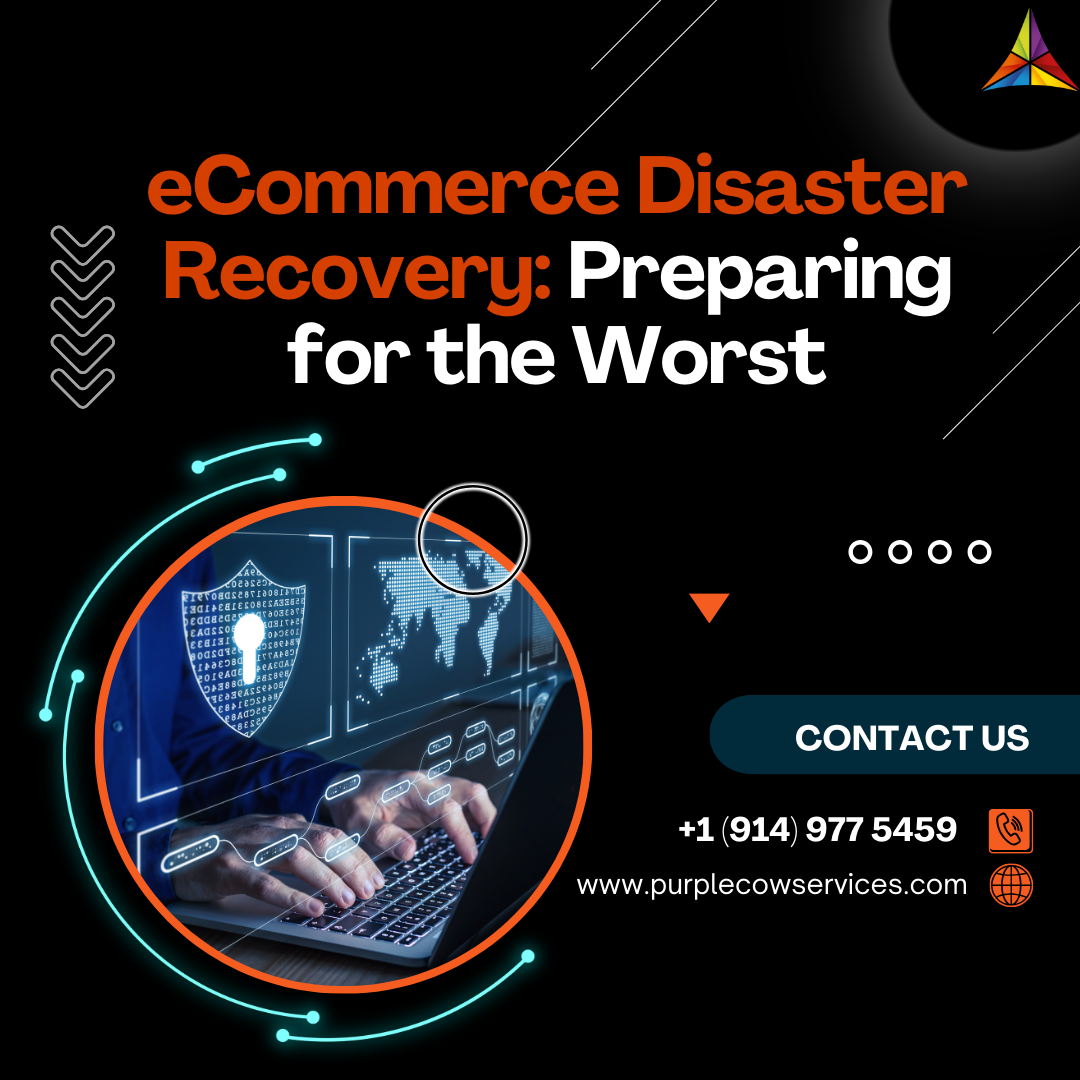In the fast-paced world of eCommerce, preparing for the worst is not just a good practice; it's essential for business survival.
Share This Story, Choose Your Platform!
In this comprehensive guide, we’ll delve into eCommerce disaster recovery, exploring why it’s crucial, what types of disasters you should prepare for, and how to develop a robust recovery plan. From natural disasters to cyberattacks, we’ll cover all aspects of eCommerce security to ensure that your online business can weather any storm.
Why eCommerce Disaster Recovery Matters
This section sets the stage by explaining the significance of eCommerce disaster recovery. We’ll discuss the potential consequences of not having a recovery plan in place and how it can affect your business. In today’s digital world, where threats come from all directions, being prepared is the first step toward ensuring business continuity.
eCommerce disaster recovery isn’t just an option; it’s a necessity. In an age where technology rules, the potential risks are numerous, including data breaches, system failures, natural disasters, and more. Without a disaster recovery plan, your eCommerce business is at risk of downtime, data loss, and damage to your reputation. Being prepared for the worst is not only a best practice but also a fundamental element of business continuity.
Identifying Potential eCommerce Disasters
This section explores the various types of disasters that can impact eCommerce businesses. From data breaches to hardware failures and natural disasters, we’ll discuss each type of threat and its potential consequences. Identifying these potential disasters is the first step toward effective disaster recovery.
Understanding the range of potential disasters is crucial. These can include data breaches, hardware failures, system crashes, natural disasters like floods or hurricanes, and cyberattacks, among others. Each type of disaster carries its own set of risks and consequences. By identifying these potential disasters, you can tailor your disaster recovery plan to address the specific threats that are most relevant to your eCommerce business.
Building a Disaster Recovery Team
A disaster recovery plan is only as effective as the team responsible for its implementation. In this section, we’ll discuss the importance of assembling a dedicated disaster recovery team. We’ll explore the roles and responsibilities of team members, ensuring that your eCommerce business has the right people in place to respond swiftly and effectively in a crisis.
Building a disaster recovery team is a critical step in the preparedness process. This team should consist of individuals with specific roles and responsibilities, from identifying and assessing risks to executing recovery procedures and communicating with stakeholders. By assembling a dedicated and well-prepared team, you ensure that the right people are in place to respond quickly and effectively in the event of a disaster.
Assessing Risks and Vulnerabilities
Risk assessment is the foundation of an effective disaster recovery plan. In this section, we’ll explore the importance of assessing your eCommerce business’s risks and vulnerabilities. We’ll discuss the methods and tools you can use to identify weaknesses in your security and infrastructure, helping you to prioritize areas for improvement.
Risk assessment is an ongoing process that helps you identify and mitigate vulnerabilities. By thoroughly evaluating your eCommerce business’s risks and weaknesses, you can prioritize areas for improvement and develop strategies to minimize potential disasters. This proactive approach to risk assessment ensures that you are well-prepared for any scenario.
Developing a Disaster Recovery Plan
This section dives into the process of developing a comprehensive disaster recovery plan. We’ll guide you through the essential components of the plan, from setting recovery objectives to creating procedures for data backup, system restoration, and crisis communication. With a well-structured plan in place, your eCommerce business can respond effectively to disasters.
Developing a disaster recovery plan is a meticulous process that involves setting clear recovery objectives, defining roles and responsibilities, and creating step-by-step procedures for various disaster scenarios. This plan should cover data backup and recovery, system restoration, and communication strategies for all stakeholders. With a well-structured disaster recovery plan, your eCommerce business can respond effectively and minimize the impact of disasters.
Data Backup and Recovery Strategies
Data is the lifeblood of eCommerce, making data backup and recovery strategies essential. In this section, we’ll explore different backup methods, including cloud storage and off-site backups. We’ll also discuss the importance of regular data testing to ensure that your eCommerce business can recover its critical information when disaster strikes.
Data backup and recovery are at the heart of eCommerce disaster recovery. This section will delve into various data backup methods, including the use of cloud storage and off-site backups. We’ll also emphasize the importance of regular data testing to ensure that your eCommerce business can recover its critical information when disaster strikes. A well-executed data backup and recovery strategy is crucial to business continuity.
System Restoration Procedures
When disaster strikes, restoring your eCommerce system swiftly is vital. This section outlines the procedures and considerations for system restoration. We’ll discuss the use of backup systems, virtualization, and the critical role of system administrators in getting your eCommerce platform back on its feet.
System restoration is a critical phase of disaster recovery. This section covers the procedures and considerations for restoring your eCommerce system as quickly as possible. We’ll discuss the use of backup systems, virtualization, and the crucial role of system administrators in getting your eCommerce platform back on its feet. Timely system restoration is key to minimizing downtime and ensuring business continuity.
Crisis Communication
Effective communication during a disaster is paramount. In this section, we’ll explore the significance of crisis communication in eCommerce disaster recovery. We’ll discuss how to communicate with employees, customers, vendors, and other stakeholders to ensure everyone is informed and knows their role in the recovery process.
Crisis communication is a fundamental aspect of eCommerce disaster recovery. This section will emphasize the importance of communicating effectively with employees, customers, vendors, and other stakeholders during and after a disaster. By ensuring everyone is well-informed and knows their role in the recovery process, you can maintain trust and transparency, even in the most challenging times.
Training and Drills
Preparation is the key to success in disaster recovery. In this section, we’ll discuss the significance of regular training and disaster recovery drills. By practicing your disaster recovery plan and ensuring that your team is well-prepared, you can identify weaknesses and improve your response to disasters.
Training and disaster recovery drills are essential to preparedness. This section highlights the importance of regular training exercises and simulations to test the effectiveness of your disaster recovery plan. By practicing and refining your plan, you can identify weaknesses, enhance team coordination, and improve your response to disasters. The more prepared your team is, the better your eCommerce business can weather any storm.
Continuous Improvement
The final section explores the concept of continuous improvement in eCommerce disaster recovery. Disaster recovery is an ongoing process, and it’s essential to continually assess and enhance your plan. We’ll discuss the significance of learning from past disasters, staying up-to-date with the latest threats, and adapting your recovery plan accordingly.
Continuous improvement is the cornerstone of effective eCommerce disaster recovery. In this final section, we’ll emphasize the importance of learning from past disasters, staying informed about the latest threats, and adapting your recovery plan accordingly. Disaster recovery is an ongoing process, and your ability to evolve and improve is key to ensuring the resilience of your eCommerce business.
Conclusion
eCommerce disaster recovery is not a choice; it’s a commitment to building resilience in the face of adversity. By understanding the importance of disaster recovery, identifying potential threats, assembling a dedicated team, and developing a comprehensive plan, your eCommerce business can thrive even in the worst circumstances. Remember, in the digital world, preparation isn’t just an option; it’s a necessity for long-term success and customer trust.
eCommerce businesses must prioritize disaster recovery to build resilience and maintain customer trust. By recognizing the significance of disaster recovery, identifying potential threats, assembling a dedicated team, and developing a comprehensive plan, your eCommerce business can thrive even in the worst circumstances. In the ever-evolving digital landscape, preparation isn’t just an option; it’s a necessity for long-term success and maintaining the trust of your customers.
Empower your eCommerce business with Purple Cow Services‘ robust eCommerce Disaster Recovery solutions. Our comprehensive approach ensures you’re prepared for any crisis, from data breaches to natural disasters. With a dedicated disaster recovery team, thorough risk assessment, and effective strategies for data backup, system restoration, and crisis communication, we’ll safeguard your business’s continuity. Choose Purple Cow Services for resilience and peace of mind in the face of adversity.
Share This Story, Choose Your Platform!
In This Blog:
- Why eCommerce Disaster Recovery Matters
- Identifying Potential eCommerce Disasters
- Building a Disaster Recovery Team
- Assessing Risks and Vulnerabilities
- Developing a Disaster Recovery Plan
- Data Backup and Recovery Strategies
- System Restoration Procedures
- Crisis Communication
- Training and Drills
- Continuous Improvement
- Conclusion

















